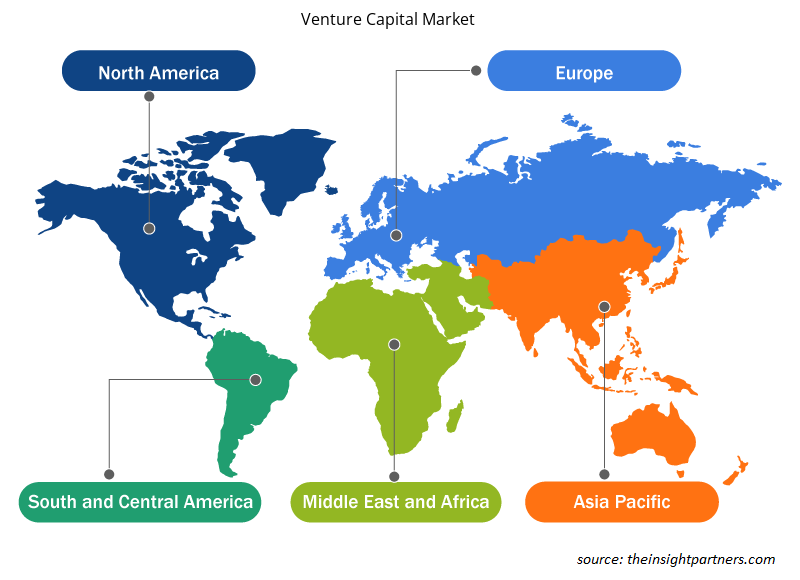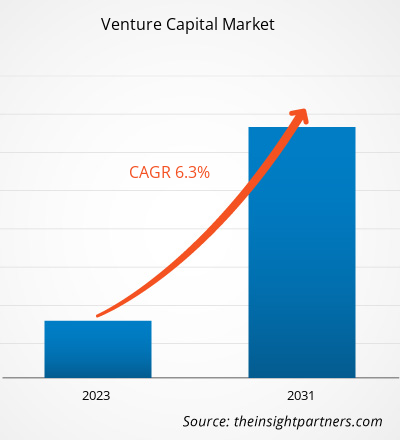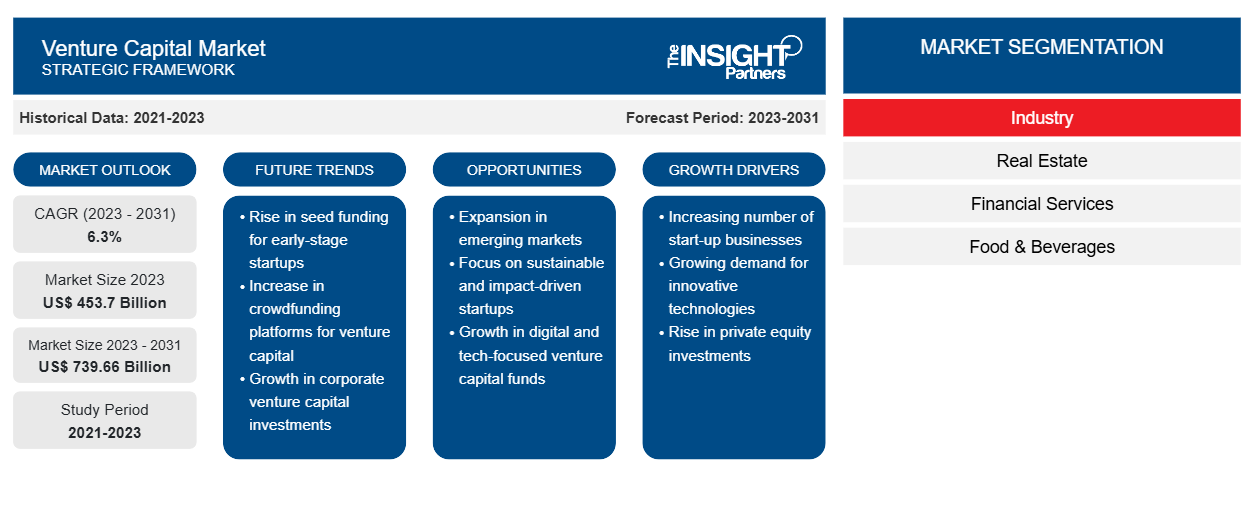من المتوقع أن ينمو حجم سوق رأس المال الاستثماري من 453.7 مليار دولار أمريكي في عام 2023 إلى 739.66 مليار دولار أمريكي بحلول عام 2031؛ ومن المتوقع أن يتوسع بمعدل نمو سنوي مركب قدره 6.3٪ من عام 2023 إلى عام 2031. يتضمن سوق رأس المال الاستثماري آفاق نمو بسبب اتجاهات سوق رأس المال الاستثماري الحالية وتأثيرها المتوقع خلال فترة التنبؤ. يعد العدد المتزايد من الشركات الناشئة والتصنيع والعولمة من العوامل التي تدفع نمو السوق. ومع ذلك، فإن تقلبات السوق والتحديات التنظيمية تقيد نمو السوق.
تحليل سوق رأس المال الاستثماري
يمثل رأس المال الاستثماري مجموعة فرعية من الأسهم الخاصة التي توفر التمويل للشركات الناشئة والصغيرة ذات آفاق التوسع المستدام. البنوك الاستثمارية والمؤسسات المالية والمستثمرون هم المصادر المعتادة لرأس المال الاستثماري. يمول رأس المال الاستثماري الشركات الناشئة والشركات الصغيرة التي يعتقد المستثمرون أنها تتمتع بإمكانات تطوير كبيرة. الأسهم الخاصة هي الشكل المعتاد للتمويل. من خلال الشراكات المحدودة المستقلة، يتم بيع حصص الملكية لمجموعة مختارة من المستثمرين. في حين يمول رأس المال الاستثماري عادةً الشركات القائمة التي تبحث عن حقنة أسهم، يركز رأس المال الاستثماري عادةً على تطوير الشركات. رأس المال الاستثماري هو مصدر حيوي للتمويل، وخاصة للشركات الناشئة التي لا تستطيع الوصول إلى قروض البنوك أو أسواق رأس المال أو أشكال أخرى من الديون. التمويل في مرحلة البذور والمرحلة المبكرة والمرحلة المتأخرة هي الأنواع الثلاثة لرأس المال الاستثماري.
لقد تطورت العولمة في العقود الأخيرة نتيجة لتوسع الشبكات التجارية والمالية التي تعبر الحدود الوطنية، مما جعل الشركات والعمال من الاقتصادات الأخرى مترابطين بشكل متزايد. إن العولمة الأكبر تخلق المزيد من الفرص للاستثمارات الدولية، مما يؤدي إلى المزيد من البرامج المرتبطة بالاستثمار. وعلاوة على ذلك، تسهل الصناعة أيضًا زيادة الاستثمارات والتعاون عبر الأوسع والشراكات والمشاريع المشتركة، مما يسهل نمو سوق رأس المال الاستثماري.
قم بتخصيص هذا التقرير ليناسب متطلباتك
ستحصل على تخصيص لأي تقرير - مجانًا - بما في ذلك أجزاء من هذا التقرير، أو تحليل على مستوى الدولة، وحزمة بيانات Excel، بالإضافة إلى الاستفادة من العروض والخصومات الرائعة للشركات الناشئة والجامعات
- احصل على أهم اتجاهات السوق الرئيسية لهذا التقرير.ستتضمن هذه العينة المجانية تحليلاً للبيانات، بدءًا من اتجاهات السوق وحتى التقديرات والتوقعات.
نظرة عامة على صناعة رأس المال الاستثماري
- يقدم رأس المال الاستثماري الدعم المالي للشركات الناشئة التي تفتقر إلى التدفق النقدي اللازم لتحمل الديون. ولأن المستثمرين يستحوذون على أسهم الشركات المحتملة وتتلقى الشركات التمويل الذي تحتاجه لبدء عملياتها، فقد يكون هذا الترتيب مفيدًا لكلا الطرفين.
- تقدم شركات رأس المال الاستثماري في كثير من الأحيان خدمات التواصل والتوجيه للمساعدة في تحديد المستشارين والمواهب. إن الحصول على دعم قوي من رأس المال الاستثماري يمكن أن يساعد الشركات على القيام بمزيد من الاستثمارات.
- ومع ذلك، فإن الشركات التي تقبل دعم رأس المال الاستثماري قد تفقد السيطرة الإبداعية على توجهاتها المستقبلية. ومن المرجح أن يرغب المستثمرون في الحصول على حصة كبيرة من أسهم الشركة، بل وربما يفرضون ضغوطاً على فريق الإدارة.
- قد يضغط العديد من شركات رأس المال الاستثماري على الشركة للخروج بسرعة لأن هدفها الرئيسي هو تحقيق عائد سريع ومرتفع.
محرك سوق رأس المال الاستثماري
زيادة عدد الشركات الناشئة لقيادة سوق رأس المال الاستثماري
- إن سهولة الوصول إلى التكنولوجيا والموارد وثقافة ريادة الأعمال والابتكار المتنامية تجعل من السهل على الأفراد الذين لديهم أفكار تحويلها إلى أعمال قابلة للاستمرار. على سبيل المثال، وفقًا لـ SBA، في عام 2022، كان هناك 30.2 مليون شركة صغيرة تعمل و1000 شركة يونيكورن نشطة في الولايات المتحدة.
- وفقًا لـ CB Insights، اعتبارًا من يناير 2024، يوجد أكثر من 1200 شركة ناشئة يونيكورن بقيمة مليار دولار في العالم. وعلاوة على ذلك، وفقًا لشركة Microsoft، يتم إنشاء 50 مليون شركة ناشئة جديدة كل عام. وهذا يعني أنه في المتوسط، يتم إطلاق 137000 شركة ناشئة كل يوم.
- مع قيام المزيد من رواد الأعمال بإطلاق شركات ناشئة بأفكار مبتكرة، فإنهم يسعون للحصول على التمويل لتنمية أعمالهم.
- إن المستثمرين المغامرين، الذين ينجذبون إلى إمكانية تحقيق عوائد مرتفعة، يستثمرون في هذه الشركات الناشئة في مقابل الحصول على أسهم. ويساهم هذا التدفق من رأس المال في تغذية نمو الشركات الناشئة، مما يسمح لها بتوسيع عملياتها وتطوير منتجات جديدة ودخول أسواق جديدة.
- مع نجاح الشركات الناشئة في توليد العوائد للمستثمرين، يتم جذب المزيد من رأس المال إلى سوق رأس المال الاستثماري، مما يخلق دورة من النمو.
- وتساهم قصص نجاح الشركات الناشئة المعروفة في تغذية هذه الدورة بشكل أكبر، مما يلهم المزيد من رواد الأعمال على اتخاذ هذه الخطوة والسعي للحصول على التمويل، وبالتالي دفع نمو سوق رأس المال الاستثماري.
تحليل تجزئة تقرير سوق رأس المال الاستثماري
- اعتمادًا على النوع، يتم تقسيم سوق رأس المال الاستثماري إلى مستثمرين محليين ومستثمرين دوليين.
- ومن المتوقع أن يحظى قطاع المستثمرين المحليين بحصة كبيرة في سوق رأس المال الاستثماري في عام 2023.
- غالبًا ما يكون لدى المستثمرين المحليين فهم أعمق لديناميكيات السوق المحلية واللوائح والفروق الثقافية، مما قد يمنحهم أفضلية في تحديد فرص الاستثمار الواعدة.
- ومن ناحية أخرى، قد يجلب المستثمرون الدوليون شبكات أوسع، ووجهات نظر متنوعة، والقدرة على الوصول إلى مجموعات أكبر من رأس المال، وهو ما قد يكون مفيدا للشركات الناشئة التي تتطلع إلى التوسع عالميا.
تحليل حصة سوق رأس المال الاستثماري حسب المنطقة الجغرافية
ينقسم نطاق سوق رأس المال الاستثماري بشكل أساسي إلى خمس مناطق - أمريكا الشمالية وأوروبا وآسيا والمحيط الهادئ والشرق الأوسط وأفريقيا وأمريكا الجنوبية. تشهد أمريكا الشمالية نموًا سريعًا ومن المتوقع أن تحتفظ بحصة كبيرة في سوق رأس المال الاستثماري. ساهم التطور الاقتصادي الكبير في المنطقة والنمو السكاني والعدد المتزايد من الشركات الناشئة التي تتطلب رأس مال استثماري في نمو السوق.
رؤى إقليمية حول سوق رأس المال الاستثماري
لقد قام المحللون في Insight Partners بشرح الاتجاهات والعوامل الإقليمية المؤثرة على سوق رأس المال الاستثماري طوال فترة التوقعات بشكل شامل. كما يناقش هذا القسم أيضًا قطاعات سوق رأس المال الاستثماري والجغرافيا في جميع أنحاء أمريكا الشمالية وأوروبا ومنطقة آسيا والمحيط الهادئ والشرق الأوسط وأفريقيا وأمريكا الجنوبية والوسطى.

- احصل على البيانات الإقليمية المحددة لسوق رأس المال الاستثماري
نطاق تقرير سوق رأس المال الاستثماري
| سمة التقرير | تفاصيل |
|---|---|
| حجم السوق في عام 2023 | 453.7 مليار دولار أمريكي |
| حجم السوق بحلول عام 2031 | 739.66 مليار دولار أمريكي |
| معدل النمو السنوي المركب العالمي (2023 - 2031) | 6.3% |
| البيانات التاريخية | 2021-2023 |
| فترة التنبؤ | 2023-2031 |
| القطاعات المغطاة | حسب الصناعة
|
| المناطق والدول المغطاة | أمريكا الشمالية
|
| قادة السوق وملفات تعريف الشركات الرئيسية |
|
كثافة اللاعبين في سوق رأس المال الاستثماري: فهم تأثيرها على ديناميكيات الأعمال
يشهد سوق رأس المال الاستثماري نموًا سريعًا، مدفوعًا بالطلب المتزايد من جانب المستخدم النهائي بسبب عوامل مثل تفضيلات المستهلكين المتطورة والتقدم التكنولوجي والوعي المتزايد بفوائد المنتج. ومع ارتفاع الطلب، تعمل الشركات على توسيع عروضها والابتكار لتلبية احتياجات المستهلكين والاستفادة من الاتجاهات الناشئة، مما يؤدي إلى زيادة نمو السوق.
تشير كثافة اللاعبين في السوق إلى توزيع الشركات أو المؤسسات العاملة في سوق أو صناعة معينة. وهي تشير إلى عدد المنافسين (اللاعبين في السوق) الموجودين في مساحة سوق معينة نسبة إلى حجمها أو قيمتها السوقية الإجمالية.
الشركات الرئيسية العاملة في سوق رأس المال الاستثماري هي:
- تايجر جلوبال مانجمنت
- شركاء المشاريع الجديدة
- سيكويا كابيتال
- دي إس تي جلوبال
- آي دي جي كابيتال
إخلاء المسؤولية : الشركات المذكورة أعلاه ليست مرتبة بأي ترتيب معين.

- احصل على نظرة عامة على أهم اللاعبين الرئيسيين في سوق رأس المال الاستثماري
"تحليل سوق رأس المال الاستثماري"تم تنفيذه على أساس النوع والصناعة والجغرافيا. على أساس النوع، يتم تقسيم السوق إلى مستثمرين محليين ومستثمرين دوليين. بناءً على الصناعة، يتم تقسيم سوق رأس المال الاستثماري إلى العقارات والخدمات المالية والأغذية والمشروبات والرعاية الصحية والنقل والخدمات اللوجستية وتكنولوجيا المعلومات وخدمات تكنولوجيا المعلومات والتعليم وغيرها. بناءً على الجغرافيا، يتم تقسيم السوق إلى أمريكا الشمالية وأوروبا ومنطقة آسيا والمحيط الهادئ والشرق الأوسط وأفريقيا وأمريكا الجنوبية.
أخبار سوق رأس المال الاستثماري والتطورات الأخيرة
تتبنى الشركات استراتيجيات غير عضوية وعضوية مثل عمليات الدمج والاستحواذ في سوق رأس المال الاستثماري. وفيما يلي بعض التطورات الرئيسية التي شهدتها السوق مؤخرًا:
- في نوفمبر 2023، أعلنت شركة IBM عن إطلاق صندوق استثماري بقيمة 500 مليون دولار أمريكي للاستثمار في مجموعة من شركات الذكاء الاصطناعي - من الشركات الناشئة في المراحل المبكرة إلى الشركات ذات النمو المفرط - والتي تركز على تسريع تكنولوجيا الذكاء الاصطناعي التوليدي والبحث العلمي للمؤسسات.
[المصدر: شركة IBM، موقع الشركة على الويب]
- في سبتمبر 2023، أعلنت Amazon Catalytic Capital أنها استثمرت في أربعة صناديق رأس مال استثماري جديدة، مما رفع إجمالي محفظتها إلى ثمانية صناديق.
[المصدر: أمازون، موقع الشركة]
تقرير سوق رأس المال الاستثماري - التغطية والمخرجات
يتم تقدير توقعات سوق رأس المال الاستثماري بناءً على نتائج بحثية ثانوية وأولية مختلفة، مثل منشورات الشركات الرئيسية وبيانات الجمعيات وقواعد البيانات. يوفر تقرير السوق "حجم سوق رأس المال الاستثماري والتوقعات (2021-2031)" تحليلاً مفصلاً للسوق يغطي المجالات التالية-
- حجم السوق والتوقعات على المستويات العالمية والإقليمية والوطنية لجميع قطاعات السوق الرئيسية المشمولة بالنطاق.
- ديناميكيات السوق مثل المحركات والقيود والفرص الرئيسية.
- الاتجاهات المستقبلية الرئيسية.
- تحليل مفصل لـ PEST و SWOT
- تحليل السوق العالمي والإقليمي يغطي اتجاهات السوق الرئيسية، واللاعبين الرئيسيين، واللوائح، والتطورات الأخيرة في السوق.
- تحليل المشهد الصناعي والمنافسة الذي يغطي تركيز السوق، وتحليل الخريطة الحرارية، واللاعبين الرئيسيين، والتطورات الأخيرة.
- ملفات تعريفية مفصلة للشركة.
- التحليل التاريخي (سنتان)، سنة الأساس، التوقعات (7 سنوات) مع معدل النمو السنوي المركب
- تحليل PEST و SWOT
- حجم السوق والقيمة / الحجم - عالمي، إقليمي، بلد
- الصناعة والمنافسة
- مجموعة بيانات إكسل
التقارير الحديثة
شهادات العملاء
سبب الشراء
- اتخاذ قرارات مدروسة
- فهم ديناميكيات السوق
- تحليل المنافسة
- رؤى العملاء
- توقعات السوق
- تخفيف المخاطر
- التخطيط الاستراتيجي
- مبررات الاستثمار
- تحديد الأسواق الناشئة
- تحسين استراتيجيات التسويق
- تعزيز الكفاءة التشغيلية
- مواكبة التوجهات التنظيمية























 احصل على عينة مجانية ل - سوق رأس المال الاستثماري
احصل على عينة مجانية ل - سوق رأس المال الاستثماري